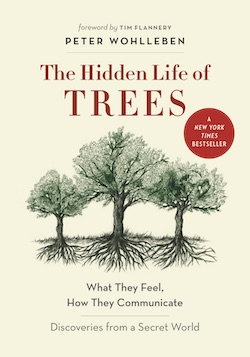SEJournal Online is the digital news magazine of the Society of Environmental Journalists. Learn more about SEJournal Online, including submission, subscription and advertising information.
BookShelf
“The Hidden Life of Trees: What They Feel, How They Communicate”
By Peter Wohlleben, foreword by Tim Flannery
Greystone Books, $24.95
Reviewed by Candace S. Hughes
 For more than 14 years, we have been living on one-and-a-quarter acres outside of Phoenix, where we have as many as 30 night-blooming cereus cactuses.
For more than 14 years, we have been living on one-and-a-quarter acres outside of Phoenix, where we have as many as 30 night-blooming cereus cactuses.
On one hot night each summer, often around solstice, plants that look like dead sticks offer large white blooms. Bats visit to pollinate. Bees visit until the blossoms fall limply in the hot sun.
We have often wondered why as many as 20 bloom on one evening — and why plants in neighboring yards also choose to open their flowers the same night.
Biologists suggest the plants are sending signals to each other. And as I read “The Hidden Life of Trees: What They Feel, How They Communicate,” I see that author Peter Wohlleben has been gathering evidence that plants not only "talk to each other” — they actually assist struggling trees and even provide sustenance.
Wohlleben, a German forester, asserts a “tree can be only as strong as the forest that surrounds it.” He believes that as trees grow together, they divide nutrients and water so each can grow to their maximum potential.
That type of natural cooperation is destroyed when managers remove trees to take out "competition," because — as the trees look for help — they find only stumps.
While some of the author's work is about European trees, his beliefs can be translated to other climes. For instance, the drought in the Western United States and Canada that is giving bark beetles a head start in killing trees is discussed when he details the deleterious effects of repeated dry spells.
The writing is easy for lay readers to understand, but also includes sound science for those wishing to study the author's methods.
Said famed Harvard University entomologist and biodiversity advocate E.O. Wilson: "To those who are steering the growth of nature reserves worldwide, let me make an earnest request: Don't stop. Just aim a lot higher."
Wohlleben is aiming higher and encouraging everyone to look for better answers. Deforestation and climate change are discussed, and the importance of leaving the old growth forests alone also is emphasized.
As Tim Flannery posits in the introduction: "Share with me the joy trees can bring us. And, who knows, perhaps on your next walk in the forest, you will discover for yourself wonders great and small."
Candace S. Hughes is an Arizona-based freelance writer. Her most recent work for Smithsonian.com is "How We Created a Monster in the American Southwest."
* From the weekly news magazine SEJournal Online, Vol. 2, No. 16. Content from each new issue of SEJournal Online is available to the public via the SEJournal Online main page. Subscribe to the e-newsletter here. And see past issues of the SEJournal archived here.













 Advertisement
Advertisement 



